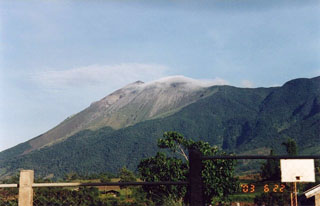Report on Kanlaon (Philippines) — 4 December-10 December 2024
Smithsonian Institution / US Geological Survey
Weekly Volcanic Activity Report, 4 December-10 December 2024
Managing Editor: Sally Sennert.
Please cite this report as:
Global Volcanism Program, 2024. Report on Kanlaon (Philippines) (Sennert, S, ed.). Weekly Volcanic Activity Report, 4 December-10 December 2024. Smithsonian Institution and US Geological Survey.
Kanlaon
Philippines
10.4096°N, 123.13°E; summit elev. 2422 m
All times are local (unless otherwise noted)
The Philippine Institute of Volcanology and Seismology (PHIVOLCS) reported a continuing eruption at Kanlaon during 3-10 December and an escalation in activity on 9 December. The seismic network recorded 6-22 daily volcanic earthquakes, and sulfur dioxide emissions ranged from 1,669 to 6,432 tonnes per day. Gas-and-steam emissions that were mostly continuous and often voluminous rose 200-500 m above the summit and drifted mainly W, WSW, and SW. There were 1-6 ash emission events during 3-5 and 7-8 December, with each lasting 3-40 minutes.
An explosive eruption occurred at 1503 on 9 December and lasted three minutes and 55 seconds. A voluminous ash plume rapidly rose 4 km above the crater rim and drifted WSW. Pyroclastic flows traveled 2-3.4 km down the SE flanks. The Alert Level was raised to 3 (on a scale of 0-5) and local governments were advised to evacuate residents within a 6 km radius. According to news articles ashfall was reported in 30 cities and towns across the municipalities of Negros Occidental, Guimaras, Iloilo, and Antique. A sulfur odor was noted in several barangays and in Bago City (20 km NW). Several schools in those areas suspended classes. The Disaster Response Operations Monitoring and Information Center (DROMIC) report issued on 10 December stated that 12,172 people (3,616 families) had evacuated mainly from Bago City, La Carlota City (14 km W), and La Castellana (16 km SW), with fewer people from Moises Padilla (17 km SSW), Magalion (14 km SSW), Murcia, Pontevedra, and Canlaon City (10 km ESE). There were 12,010 evacuees spread across 24 evacuation centers and 162 people were staying with friends or relatives.
Geological Summary. Kanlaon volcano (also spelled Canlaon) forms the highest point on the Philippine island of Negros. The massive andesitic stratovolcano is covered with fissure-controlled pyroclastic cones and craters, many of which are filled by lakes. The largest debris avalanche known in the Philippines traveled 33 km SW from Kanlaon. The summit contains a 2-km-wide, elongated northern caldera with a crater lake and a smaller but higher active vent, Lugud crater, to the south. Eruptions recorded since 1866 have typically consisted of phreatic explosions of small-to-moderate size that produce minor local ashfall.
Sources: Philippine Institute of Volcanology and Seismology (PHIVOLCS), Disaster Response Operations Monitoring and Information Center (DROMIC), Philippine News Agency (PNA)

